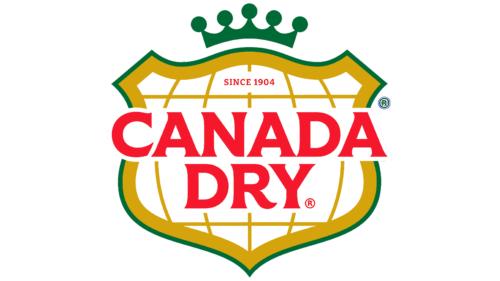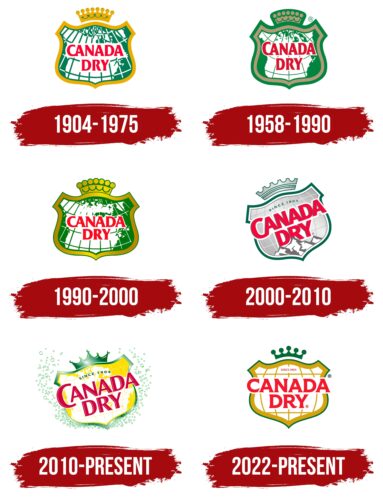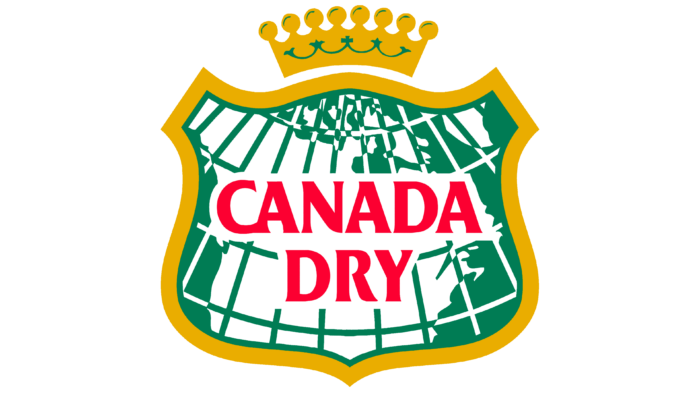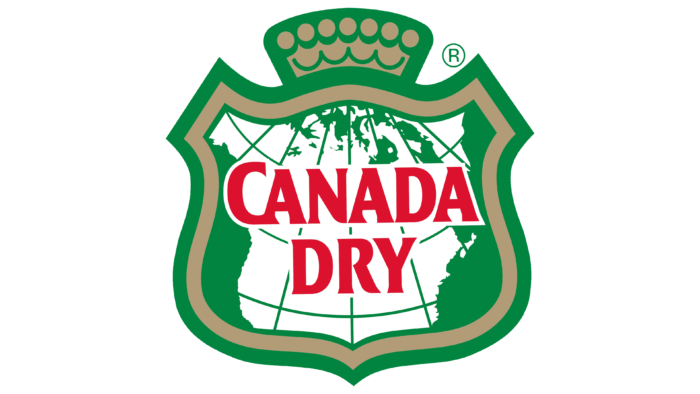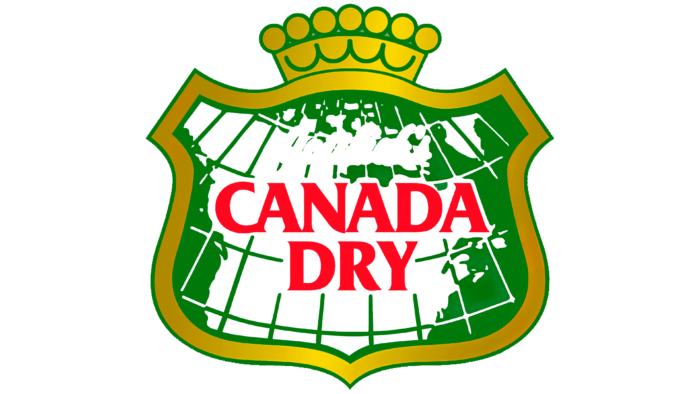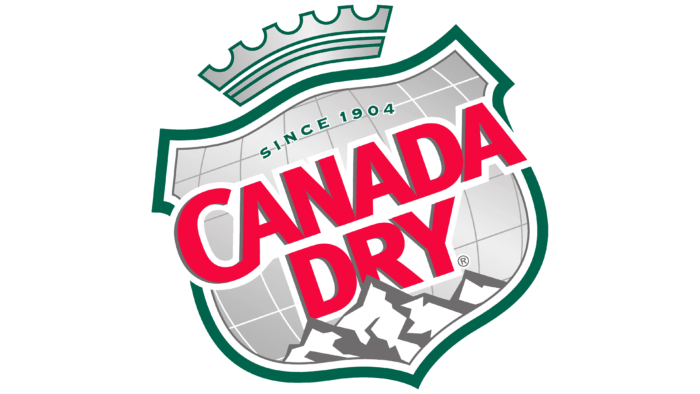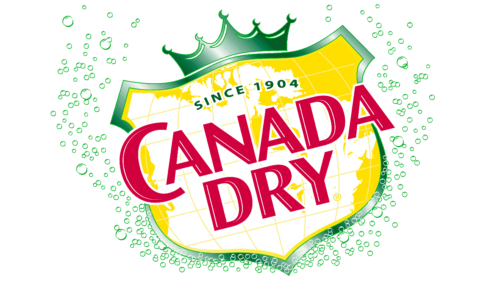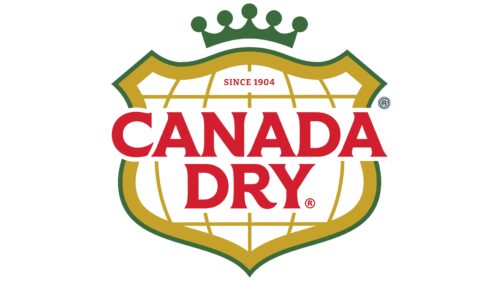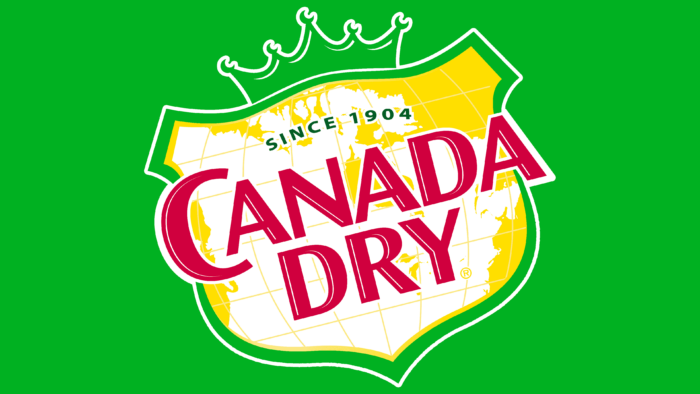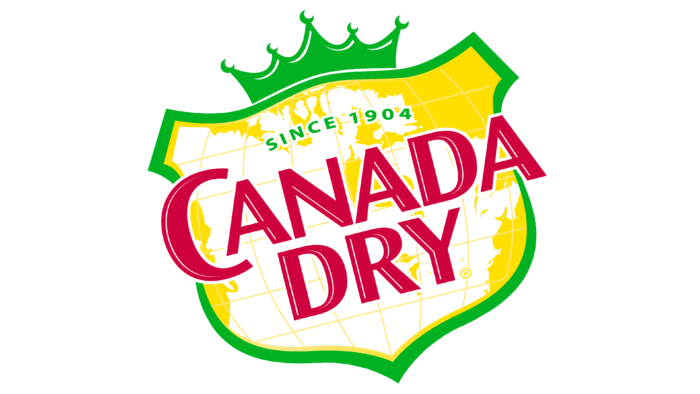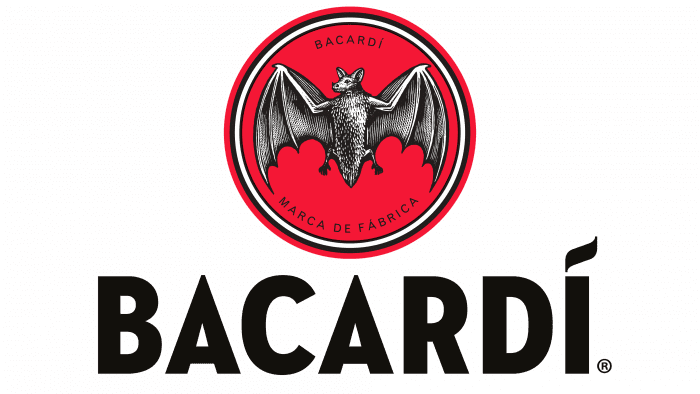The Canada Dry logo pays tribute to the country of origin and spreads the word about Canada worldwide. The elements show the premium quality and taste of the drink because, according to the emblem, the brand was served at the table of representatives of the crown.
Canada Dry: Brand overview
| Founded: | 1904 |
| Founder: | Keurig Dr Pepper |
| Headquarters: | Canada |
| Website: | canadadry.com |
Meaning and History
The Canada Dry logo has a patriotic focus and is inextricably linked to Canada. All its attributes point to this country, from the map to the choice of colors.
1904 – 1975
The drink was created by chemist and pharmacist McLaughlin. It differed in taste from other ales as it had minimal sweetness. As planned by the developer, the drink was supposed to resemble dry French champagne. This was achieved in 1904. The owner reflected this feature in the name, using the word “dry.”
The first product labels featured a beaver (the symbol of Canada) on a Canadian map. Ale received its famous logo with a crown, shield, and map of Canada three years later, when it was marked by the country’s governor-general and began to be served at his court.
The red Canada Dry inscription on the white background of the map alludes to the colors of Great Britain and France, the first colonizers of the land.
The crown above the coat of arms was in the form of a count’s crown, as the country’s governor-general was a count. This sign and the golden color of the edging of the coat of arms symbolized the patronage and approval of ale by the ruling house and also made McLaughlin ale a royal drink. The gold on the logo creates a sense of volume and shimmers like an amber ale.
The dark green background around the map is an image of the oceans surrounding Canada. The green color is also a nod to the green flag of Ontario (McLaughlin’s homeland), Canadian forests, clover, and St. Patrick (many Irish settlers live in Ontario, and the pharmacist’s surname has Irish roots).
1958 – 1990
Ginger ale quickly gained popularity, production was opened in New York, and after it began to be exported to other countries. In the early fifties, the company went on to expand and added the release of another product: Tonic Water Club Soda. She was one of the first to bottle her drinks in cans. This was reflected in the change in the logo.
The new sign was designed by Raymond Loewy, a well-known industrial designer. He had an unusual blurry image, as if under greenish water. Indeed, drinks “crossed the ocean” and began to be sold in other countries. At the same time, gold disappeared from the color scheme, leaving only green, white, and red. However, green was the most predominant.
The new color scheme echoed the country’s forested nature, the country’s flag, which featured green maple leaves until 1957. In addition, on old maps, the continents had a wide, most often dark green border, like on the logo. The changes created a clear association with Canada and the fact that the drink has a fairly long history.
1990 – 2000
Starting in 1982, Canada Dry changed hands until in 1986 it became the property of the British confectionery company Cadbury Schweppes, which by that time had changed direction and was the third-largest producer of soft drinks in the world. The appearance of new owners led to a change in the visual symbol of the brand.
Canada Dry was now related to Canada only by its origin. Drinks have been introduced and known in many countries. Therefore, on the new logo, the image of the map of Canada in the shield faded into the background. The name of the brand became central and main. It is written in large red letters and goes beyond the shield, immediately attracting attention.
The border of the shield and the crown are depicted in yellow and slightly reminiscent of the ale’s color. Outside the composition is a thin green border.
2000 – 2010
In 1999, Cadbury Schweppes sold its business to The Coca-Cola Company, leaving North America and Europe as its backbone. This was the implementation of a plan to return to the “chocolate” business. At this time, the remaining brands were undergoing changes.
The map of Canada has completely disappeared from the logo. But there was an indication of the centennial history of the brand – the inscription: “since 1904”, located above the name. The shield tilted, symbolizing the new beginning of the brand’s life. The image of mountain peaks appeared, and the color scheme changed to silver. As on a map, only meridians and parallels have been preserved, showing that the drink is popular in different countries. Light colors and mountains indicated a refreshing taste. Drinks perfectly quenched thirst due to the minimum sugar content. This message became the main one in presenting the brand on the market.
2010 – today
In 2008, the remnants of Cadbury split into two strands. The Dr. Pepper Snapple Group took over the beverage business, and the sweets company was taken over in 2010 by Kraft Foods. Canada Dry is under the jurisdiction of Keurig Doctor Pepper. It took a change to the logo to mark these innovations.
The logo partially regains its authenticity: an image of a map of Canada. The background becomes bright yellow, and the shield border becomes green. They symbolize prosperity, natural composition, yellow ginger root – the basis of ginger ale. The form of the crown changes from an earl’s to a viscount’s crown, indicating the first Governor-General of Canada to hold this title.
The brand name still goes beyond the shield, as does the brand’s drinks outside the country of origin. A more sophisticated font was chosen for letters, and volume was added.
2022 – today (Canada)
In 2022, soft drink maker Canada Dry unveiled a new logo that will only be used in its home country of Canada. The heraldic shield has retained its original shape with two projections at the top, but now it does not have the usual inclination to the right side and is aligned the same as it was a hundred years ago.
The shield still symbolizes a map drawn by parallels and meridians. However, now there is no image of Canada on it – an empty white space serves as a background. The logo’s inner lines and wide frame are in a light golden hue, while the thin outer outline is dark green, like the crown at the top. The latter, by the way, has also been changed. Now it is decorated with five fat dots. The inscription “SINCE 1904” and the brand name are painted burgundy. At the same time, for the phrase “CANADA DRY,” an individually designed font with unusually smooth curves and sharp serifs sticking out in all directions is used.
Font and Colors
All logo variations are dominated by yellow, green, white, and red colors.
- Yellow is a sign of premium quality, light, joy, good mood.
- Green – greens of Canada, the Irish roots of the drink’s creator, the naturalness of this brand of ale, care for the environment’s safety.
- White – the color of the beginning, base, white sheet. Canada Dry drinks are the basis for various cocktails. The white image of the territory of Canada indicates that the stamp originates in this country.
- Red – energy, movement, love. Drinks are loved by users, common in many countries.
The logo font is related to Microsoft JhengHei and Malgun Gothic Semilight.
Canada Dry color codes
| Pigment Red | Hex color: | #ec1c2c |
|---|---|---|
| RGB: | 236 28 44 | |
| CMYK: | 0 88 81 7 | |
| Pantone: | PMS Bright Red C |
| Satin Sheen Gold | Hex color: | #cfa629 |
|---|---|---|
| RGB: | 207 166 41 | |
| CMYK: | 0 20 80 19 | |
| Pantone: | PMS 7555 C |
| Cadmium Green | Hex color: | #106a37 |
|---|---|---|
| RGB: | 16 106 55 | |
| CMYK: | 85 0 48 58 | |
| Pantone: | PMS 7726 C |
